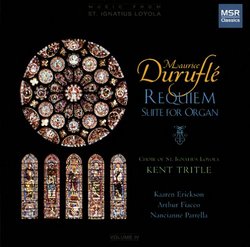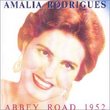| All Artists: Kaaren Erickson, Arthur Fiacco, Kent Tritle, Choir of St Ignatius Loyola Title: Durufle: Requiem (Chorus and Organ) Members Wishing: 0 Total Copies: 0 Label: MSR Classics Original Release Date: 1/1/2006 Re-Release Date: 2/14/2006 Genre: Classical Styles: Opera & Classical Vocal, Forms & Genres, Suites, Historical Periods, Early Music Number of Discs: 1 SwapaCD Credits: 1 UPC: 681585114124 |
Search - Kaaren Erickson, Arthur Fiacco, Kent Tritle :: Durufle: Requiem (Chorus and Organ)
 | Kaaren Erickson, Arthur Fiacco, Kent Tritle Durufle: Requiem (Chorus and Organ) Genre: Classical
Duruflé?s Requiem, Op.9 (1947), his longest and most popular work, offers a rich and nuanced atmosphere of solace and serenity. Conceptually speaking, this is considerably different from the dramatic and occasionally ... more » |
Larger Image |
CD Details
Synopsis
Product Description
Duruflé?s Requiem, Op.9 (1947), his longest and most popular work, offers a rich and nuanced atmosphere of solace and serenity. Conceptually speaking, this is considerably different from the dramatic and occasionally bombastic 19th-century Requiem settings, which seem more intended to terrify and awe the living than guide the departed to eternal rest and peace. Duruflé?s Requiem was surely an inevitable outgrowth of the composer?s somewhat anachronistic concerns, namely, acute sensitivity to text and timbre, seamlessly combined with compositional rigor. Each movement of Duruflé?s setting has its melodic and textual basis in the Gregorian chants from the Mass for the Dead (originally commissioned to compose an organ suite based on these chants, Duruflé later expanded it into the Requiem). He wrote: ?At times, the text is paramount, and therefore the orchestra intervenes only to sustain or to comment [in this case, the organ solo version]. At other times an original musical fabric, inspired by the text, takes over completely?notably in the ?Domine Jesu Christe?, the ?Sanctus?, and the ?Libera me.? In general I have attempted to penetrate to the essence of Gregorian style, and have tried to reconcile as far as possible the very flexible Gregorian rhythms, as established by the Benedictines of Solesmes with the exigencies of modern notation.? In his faithful representation of the implications of the text, Duruflé masterfully blended a variety of styles from the medieval to the modern period. During the Duruflés? fifth concert tour of the United States in 1971, the composer conducted several Princeton-area choirs in a performance of his Requiem; accompanist Madame Duruflé found herself very ably assisted at the organ by our own Nancianne Parrella. Duruflé?s exactness and enormous self-criticism led him to produce only a handful of works, all of the highest quality. The Suite for Organ, Op.5 (1930), was dedicated to his teacher and friend Paul Dukas, whose Impressionist style greatly influenced Duruflé. Each of the three movements was a form commonly used by Duruflé as a basis for improvisation: the brooding Prélude, waxing fortissimo and waning away; the Sicilienne, employing numerous impressionistic devices of tonal and instrumental color; and the extraordinarily virtuosic Toccata. In their joint concert tours, the Duruflés often performed the first and second movements in recital, but the composer remained dissatisfied with the Toccata movement, subjecting it to continual revision in later years.

 Track Listings (12) - Disc #1
Track Listings (12) - Disc #1
